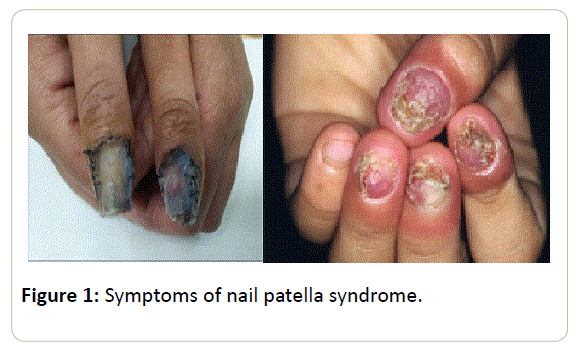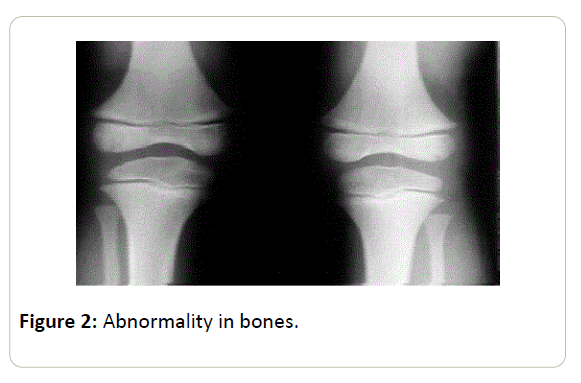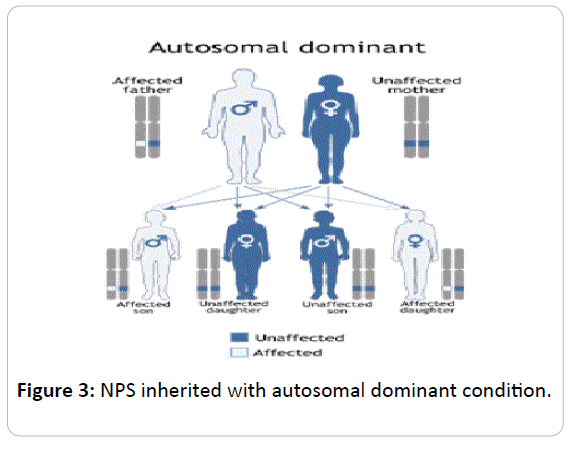Nail Patella Syndrome: An Unsound Autosomal Disorder
Supriya K, Pallavi K, Durga DK and Srinivasa Babu P
Supriya K*, Pallavi K, Durga DK and Srinivasa Babu P
Department of Pharmacy, Vignan Pharmacy College, Vadlamudi, India
- *Corresponding Author:
- Supriya K
Department of Pharmacy
Vignan Pharmacy College, Vadalmudi, India
Tel: +91 9030961817
E-mail: suppu.korrapati@gmail.com
Received Date: October 14, 2016; Accepted Date: March 20, 2017; Published Date: March 27, 2017
Citation: Supriya K, Pallavi K, Durga DK, et al. Nail Patella Syndrome: An Unsound Autosomal Disorder. Skin Dis Skin Care. 2017, 2:1.
Copyright: © 2017 Supriya K, et al. This is an open-access article distributed under the terms of the Creative Commons Attribution License, which permits unrestricted use, distribution, and reproduction in any medium, provided the original author and source are credited.
Abstract
Nail Patella Syndrome (NPS) is an autosomal dominant condition affecting the nails, skeletal system, kidneys, eyes etc. kidney problems may lead to glaucoma. This is due to alternation of mutation of gene LMX1B at 9q34. This disease will be transferred from one generation to the other generation. This is a very rare disease and can be diagnosed by genetic testing and x-ray images. Treatment includes renal transplantation, joint replacement, orthopedic surgery etc. this can be prevented by taking regular checkup for genetic concerns from the doctor. The present article deals with the symptoms, causes, epidemiology, pathophysiology, diagnosis, treatment and prevention of nail patella syndrome.
Keywords
Autosomal dominant; Gene LMX1B; 9q34 chromosome; Nause
Introduction
Nail Patella Syndrome (NPS)/Hereditary onychoosteodysplasia (HOOD syndrome)/Iliac horn syndrome/ Fong disease/Turner kieser syndrome is a rare genetic disorder of both ectodermal and endodermal origin [1]. It mainly results in small, poorly developed nails, knee caps, elbows, chest and hips. The name ‘nail patella’ is very misleading because this affects many other areas of body not only nails including the production of certain proteins. The severity of the disease varies in each individual [2].
Nail and skeletal deformities occur approximately 2.2 out of every 100,000 people. It is transmitted as a simple autosomal dominant characteristic in ABO blood group. NPS can’t skip a generation. If a patient suffering with NPS doesn’t have any family history of NPS, then it may be caused by sporadic gene mutation. The risk of transmitting the disease from parent to offspring is about 50% during pregnancy without regarding the sex of child etc. As many diseases occur due to change in nail plate, physicians sometimes observe fingernails. If there was a remarkable high incidence of renal disease in one of the family, the renal impairment severity was mostly differentiated among the patients who mostly indicate that the severity and the incidence with in family cannot be done to the gene LMX1B [3].
Symptoms
• Knees are unstable and patella are smaller or [2,4] luxated.
• Limited motion of elbows.
• Radial head subluxation.
• Erythrodysplasia of elbow.
• Exostoses from iliac bones.
• Scoliosis.
• Scapular hypoplasia.
• Loss of peripheral vision.
• Blind spots.
• Frequent change in glasses.
• Blurred vision.
• Severe headache.
• Nausea.
• Eye pain in rare cases.
• Neurological disorders.
• Affects tissues.
• Skin becomes loose and wrinkled.
• Dental problems.
• Renal problems.
• Pelvis problems.
• Constipation.
• Osteoporosis.
Causes
• Alteration or mutation of a gene LIM homeobox transcription factor-1 beta (LMX1B) necessary for a development of limbs, eyes and kidneys present on long arm chromosome 9.
• Possession of single copy of defective gene (Figure 1).
• NPS is associated with open angle glaucoma, a condition caused by blockage of the outflow of fluid from the front chamber of eyes [5].
Abnormalities
• If this genetic disorder occurs, the main abnormalities that are seen in nail patella syndrome are ocular abnormality, kidneys abnormality and an abnormality in nervous system [4,5].
• Abnormalities are seen in hands legs and teeth [6].
• In this disease, effects are mainly on nails i.e., we observe some cracks and ridges and improper growth of nails [7].
• Ultra structural changes (Figure 2) occur almost in all patients and these are independent on degree of renal function impairment [8].
• Chronic kidney disease, Cushing’s disease in dogs and even some radiology disease may also occur [9].
Molecular Analysis of Patients
• Sanger sequencing of exons [9].
• Multiplex ligation-dependant probe amplification (MLPA).
• Array-based comparative genomic hybridization (CGH).
• Genomic sequencing of whole LMX1B.
Epidemiology
The frequency of prevalence is estimated to be 1 case in 50,000 births. No clear racial predominance is recognized for this disease. Both sexes will be equally affected and there is no particular age for this disease. People of any age may get this disease. It has been described in multiple populations. Renal disease may occur in 30-50% of the patients but only 5% reach the end stage. Both males and females are equally affected [10].
Pathophysiology
NPS is an autosomal inherited dominant trait with high penetration and variance. The autosomal recessive mode is also present. In a survey it has been told that 88% of the individuals with NPS have an affected parent [11]. Dreyer et al has described the gene responsible for NPS in 1998. The protein encoded by the gene LMX1B is mainly responsible for the dorsoventral patterning of the limb, morphogenesis of glomerular basement membrane and anterior segment of eye and is involved in the regulation of collagen IV expression and in transcriptional regulation [12].
NPS locus is linked to that of the ABO blood group and adenylate kinase enzyme and linked to the alkyl chain of type 5 collagen. Nephropathy is a serious disorder of NPS. Kidney disease and glaucoma are part of (Figure 3) syndrome. The diagnostic tetrad includes fingernail dysplasia, absent or hypoplastic patellae, iliac horns and hypoplasia of radial heads. Curtis et al told that patients with NPS are indistinguishable from patients with good pasture disease. Glaucoma and nephropathy are the most serious complications. Asymptomatic proteinuria may persist for years [13].
Diagnosis
Diagnosis of nail patella syndrome can be made at birth, but it will remain undiagnosed for several generations. As this is untreated it will transfer from one generation to the other generation. Genetic testing is generally done to characterize the disorder. Diagnosis is confirmed by X-ray images of affected bones [14]. Diagnosis is done mostly based on abnormalities of finger nails and knee caps which are visual. 80% of the patients with bony pelvic spurs and nail patella syndrome are suffering from any other disease. Prenatal diagnosis and genetic testing of cells can also be done. Prenatal testing cannot give the (Table 1) extent of disease in a person. Diagnosis mainly includes nail changes, knee involvement, elbow involvement, iliac horns [15,16].
| Pedigree Number | Age (years) | Sex | Nails | Knees |
|---|---|---|---|---|
| 1-10 (dead) | - | Male | Details not known | Details not known |
| 1-20 (dead) | - | Female | Details not known | Details not known |
| 11-2 | 60 | Female | All nails both hands markedly dysplastic | Patella hypoplastic |
| 11-7 | 50 | Female | Both thumb nails effected | Patella small |
| 111-2 | 32 | Male | Thumb and index nails both hands effected | Patella small |
| 111-9 | 15 | Female | Thumb nails effected. Platynychia of right index and koilonychia of left index | Patella small. |
| Genu valgum both sides | ||||
| 111-10 | 13 | Female | Thumb, index, middle and ring finger nails on both sides effected | Patella small |
| 111-11 | 11 | Male | Thumb nails effected. Index nails show platonychia | Patella small |
| 111-12 | 33 | Male | Thumb and index nails both hands effected | Patella small |
| 111-14 | 27 | Female | Thumb and index nails effected | Patella small |
| 111-15 | 24 | Male | Thumb nails effected | Patella small |
Table 1: Details of effected individuals.
Care for Individuals with NPS
• Many persons find it difficult to obtain a care from primary care provider who doesn’t know anything about the clinical manifestations of NPS [17] when the patient enters the office.
• Orthopaedist/nephrologist/geneticist takes care eventually.
• Physician should be carefully investigating every possible clinical component of disease state.
• Nephropathy screening may be done annually starting from birth.
Treatment
• Glaucoma can’t be cure but can be controlled by eye drops pills, laser procedures etc. periodic examinations are used to prevent [18,19] loss of vision.
• Renal transplantation has been successful in people who develop end-stage renal disease.
• Joint replacement is helpful in cases of osteoarthritis of the knee or elbow.
• MRI reveals the abnormal muscle and nerve insertions which complicate the orthopedic procedures.
• Orthopedic surgery may be necessary for congenital club foot deformity.
• 10% of the people die because of renal insufficiency.
• ACE inhibitors are used to treat proteinuria and hypertension.
Prevention
The patients suffering with this disease should take the genetic concerns. If this is not cured it will be transferred to the next generation. Genetic testing should be done if there is any family history of NPS. The patient should visit the doctor regularly in order to prevent serious complications [20].
Conclusion
Nail patella syndrome is mainly caused due to mutations in gene and is transferred from parent generation to daughter generation. There are many symptoms for this disease like neurological disorders, bone disorders, dental disorders etc. By genetic testing, nail patella syndrome can be identified and there are number of treatments for the particular disease.
References
- Duthie RB, Hecht F (1963) The Inheritance and Development of the Nail-patella Syndrome. The Bone and Joint Journal 45: 259.
- Lawler SD, Renwick JH, Hauge M, Mosbech J, Wildervanck LS (1958) Linkage Tests involving the P Blood Group Locus and Further Data on the ABO: Nail-patela Linkage. Ann Hum Genet 22: 342.
- Rewick JH, Lawler SD (1955) Genetical Linkage Between the ABO and Nail-patella Loci. Ann Hum Genet 19: 312.
- Sharma JC (1966) Nail-patella Syndrome in an Indian Family. Ann Hum Genet 30: 193.
- Lawler SD, Rewick JH, Wildervanck LS (1957) Further Families Showing Linkage Between the ABO and Nail-patella Loci, with No Evidence of Heterogeneity. Ann Hum Genet 21: 410.
- Sabnis SG, Antonovych TT, Argy WP, Rakowski TA, Gandy DR, et al. (1980) Nail-patella syndrome. Clin Nephrol 14: 148-153.
- Knoers NVAM, Bongers EMHF, Van Beersum SEC, Lommen EJP, Bokhoven HV, et al. (2000) Nail-Patella syndrome: Identification of mutations in the LMX1B Gene in Dutch families. J Am Soc Nephrol 11: 1762-1766.
- Pearce RL (1970) The Nail-Patella syndrome. Med J Aust 1: 994-997.
- Norton AC, Mescom H (1968) Nail Patella-Elbow syndrome. Arch Derm 98: 372-374.
- Leahy MS (1966) The hereditory nephropathy of osteo onchodysplasia. Nail-Patella syndrome. Am J Dis Child 112: 237-241.
- Rizzo R, Pavone L, Micali G, Hall JG (1993) Familial bilateral antecubital pterugia with severe renal involvement in nail-patella syndrome. Clin Genet 44: 1-7.
- Darlington D, Resnick D (1987) The horn: a pathagnomonic feature of paediatric bone dysplasias. Aust Paediatr J 49: 164-174.
- Lane JE, Walker AN, Chandler PW, Gresen KW (1999) Nail-Patella Syndrome: an incidental finding from abdominal discomfort. South Med J 92: 1213-1215.
- Guidera KJ, Satterwhite Y, Ogden JA, Pugh L, Ganey T (1991)Nail patella syndrome: a review of 44 orthopaedic patients. J Pediatr Orthop 11: 737-742.
- Chan PC, Chan KW, Cheng IK, Chan MK (1988) Living- related renal transplantation in a patient with nail-patella syndrome. Nephron 50: 164-166.
- Little EM (1897) Congenital absence or delayed development of the patella. Lancet 2: 781.
- Daniel CR, Osment LS, Noojin RO (1980) Triangular lunulae, A clue to nail-patella syndrome. Arch Dermatol 116: 448.
- Ben BM, Cohen, L, Rosenfeld J (1971) The glomerular basement membrane in the nail-patella syndrome. Arch Pathol 92: 350.
- Del Pozo E, Lapp H (1970) Ultrastructure of the kidney in the nephropathy of the nail-patella syndrome. Am J Clin Pathol 54: 845.
- Schulz-Butulis BA, Welch MD, Norton SA (2003) Nail-patella Syndrome. J Am Acad Dermatol 49: 1086-1087.
Open Access Journals
- Aquaculture & Veterinary Science
- Chemistry & Chemical Sciences
- Clinical Sciences
- Engineering
- General Science
- Genetics & Molecular Biology
- Health Care & Nursing
- Immunology & Microbiology
- Materials Science
- Mathematics & Physics
- Medical Sciences
- Neurology & Psychiatry
- Oncology & Cancer Science
- Pharmaceutical Sciences



